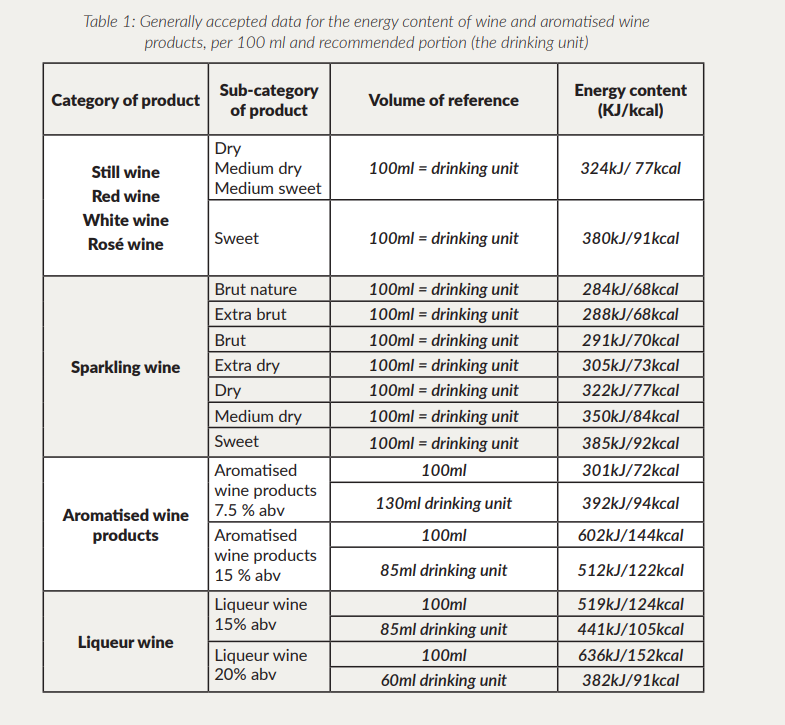Sub-section list:
Ingredients – Rules to be Known
- Use “grapes” for “grape must” and “concentrated grape must” for “rectified concentrated grape must.”
- “Tirage liqueur” and “shipping liqueur” may be indicated without specifying individual ingredients.
- Up to three ‘acidity regulators’ and ‘stabilising agents’ are allowed, with at least one used in the process.
- When blending wines with identical ingredients, list each ingredient only once.
- List ingredients in descending order of weight as used during manufacturing. Ingredients below 2% has to be listed after the other ingredients.
- EU 169/2011 ANNEX VII
Packing gas additions (carbon dioxide, argon, and nitrogen) which have the primary goal of displacing oxygen during bottling, but they do not form part of the ingredients.
In this case, you can choose to include either:
- “Bottled in a protective atmosphere”
- “Bottling may occur in a protective atmosphere”
Nutrition Information
Guidelines for expressing “0g” for insignificant amounts of fat, saturates, protein, and salt are included in the EU guidance texts on nutritional labeling, including EU 1169/2011 (see section 6, table 4).
Although you are accountable for disclosing values that surpass these caps, a number of organizations and legal professionals have declared that ordinary wines don’t need any further testing.
The EU has standardized the acceptable tolerances. Therefore, a tolerance of 2 g/100 ml (equivalent to 20 g/l) is allowed for sugar/carbohydrate statements for wines with a sugar concentration of less than 100 g/l (typically all wines except sweet wines).
The permissible tolerances are standardized throughout the EU. As a result, for wines having a sugar content of less than 100 g/l (usually all wines except sweet wines), a tolerance of 2 g/100 ml (equal to 20 g/l) is permitted for sugar/carbohydrate declarations.
Packaging
According to Italian law (Decreto legislativo 3 aprile 2006, n. 152), it is mandatory to include material identification codes and trash collection rules on your packaging.
You can do this by researching and selecting the appropriate resources.
For more information, you can refer to the official documentation.
Questions and Answers
What is a QR code?
QR codes, or Quick Response codes, are character strings that can be read or scanned by many smartphones and tablets. They are a type of barcode, similar to those found on food packaging, consisting of black and white dots arranged in a rectangle. QR codes provide a convenient way to access additional electronic information, making them ideal for wine labels.
Do I need different E-Labels for every vintage of the same wine produced?
According to FIC Regulation, the tolerances for the nutrition declaration of wine indicate that the energy value and the amount of nutrients should be labeled as the ‘average value.’ This represents the value that best reflects the nutrient content of a given wine, considering natural and seasonal variability, consumption patterns, and other factors. Therefore, separate E-Labels for each vintage may not be necessary.

Where do I get the nutritional information?
Our platform features a calculator that allows you to input the alcohol percentage and residual sugar, and we calculate the energy value for you based on EU conversion factors.
What about glycerol and organic acid concentration? Are they used in energy calculation?
Yes, we include glycerol and organic acid concentration in our calculations. It is reasonable to assume a standard glycerol concentration of 10 g/L for red wines and 5 g/L for white wines, based on established data. For red wines, the energy contribution from glycerol per 100 mL can be assumed to be 10 kJ, and for white wines, it can be assumed to be 5 kJ.
Further reading
- Questions and answers on the implementation of new EU wine label
- Labelling Nutrition,Vitamins,Minerals guidance and tolerances
- How to calculate wine energy values for wine exported to EU
- The self-regulatory proposal from the european alcoholic beverages sectors on the provision of nutrition information and ingredients